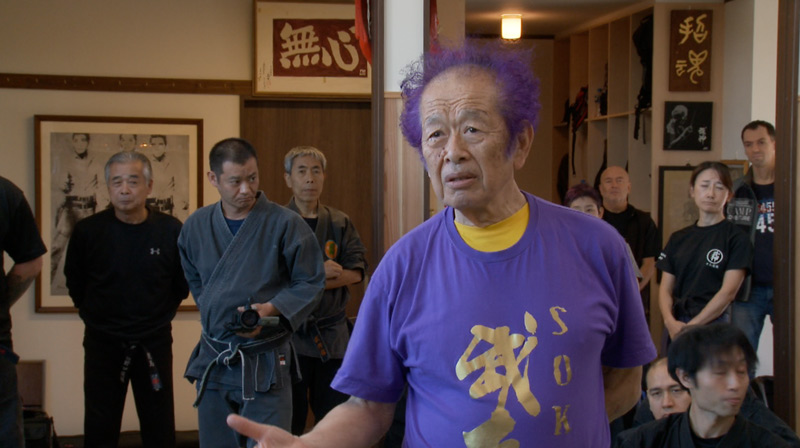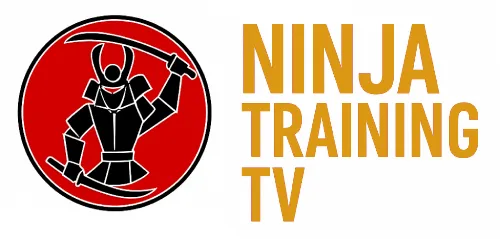
The Bujinkan (divine warrior training hall or warrior god training hall), is an international Ninjustu organization based out of Noda City, Chiba prefecture, Japan. It is headed by Dr. Masaaki Hatsumi, the 34th Togakure Ryu Soke (Grandmaster). Founded in 1974, the Bujinkan contains the knowledge of nine ryu (schools); three are ninjutsu ryu and six are samurai ryu.
The nine schools were inherited by Dr. Hatsumi from Toshitsugu Takamatsu after his passing in 1972. Toshitsugu was taught Shinden Fudo Ryu by his grandfather Toda Shinryuken Masamitsu who was Soke of this ryu and direct descendant of Tozawa Hakuunsai, founder of Gyokko Ryu Kosshijutsu. Young Toshitsugu was also taught Togakure ryu and Koto ryu which he mastered by age thirteen. By age seventeen Toshitsugu received the Menkyo Kaiden (license of total transmission), of Takagi Yoshin Ryu from Mizuta Yoshitaro Tadafusa. He also learned Kuki Happo Biken no Jutsu, Hon Tai Takagi Yoshin Ryu, and Gikan Ryu Koppojutsu from Ishitani Matsutaro Takekage. By age 22, Toshitsugu received Menkyo Kaiden from his grandfather Toda.

While in his twenties, Toshitsugu traveled to China participating on both combat situations and challenges to the death and also sport competitions. Toshitsugu also served as a personal bodyguard to the last emperor of China, Pu Yi. He returned to Japan in 1919 and became a head monk of esoteric Buddhism at a mountain temple in the Yamato district. While teaching martial arts in the Nara prefecture in 1957 he met Hatsumi Yoshiaki who would later change his name to Masaaki Hatsumi under the suggestion of Toshitsugu.
At the time, Hatsumi’s name was Yoshiaki. He was a bone doctor in the Chiba prefecture and was in search of martial art that reedited the sport versions that he practiced until this point. At the time Yoshiaki had no idea that Toshitsugu Takamatsu was the last “combat ninja” trained in the ancient arts of Ninjutsu tradition.
Toshitsugu once told Yoshiaki that he had, in fact, been waiting on Yoshiaki. Maybe not him specifically, but someone whom he thought would be worthy to pass so much knowledge to. After may years or training, Hatsumi sat with Toshitsugu one weekend when without notice, the master left the room while Hatsumi patiently waited sipping tea. Feeling that a threat was near, he ducked to the side as the sharp blade of a sword pierced the space where he once was. It was a test, and Hatsumi passed as Toshitsugu bestowed upon him the title 34th Soke of Togakure Ryu Ninpo Taijutsu. This ryu was one of the last schools of ninjutsu to survive roughly 900 years of turmoil and change in Japan. Hatsumi would go on to earn eight more of the ancient traditions.
The Nine Schools of the Bujinkan:
(number represents Dr. Masaaki Hatsumi’s lineage)
- Togakure Ryu Ninpo – Hidden Door School – 34th Grandmaster
- Gyokko Ryu Kosshijutsu – Jewel Tiger School – 28th Grandmaster
- Shinden Fudo Ryu Dakentaijutsu – Immovable Heart School – 26th Grandmaster
- Kukishinden Ryu Happo Hikenjutsu – Nine Demon Gods School – 26th Grandmaster
- Gyokushin Ryu Ninpo – Jeweled Heart School – 21st Grandmaster
- Koto Ryu Koppojutsu – Tiger Knocking Down School – 18th Grandmaster
- Takagi Yoshin Ryu Jutaijutsu – High Tree, Raised Heart School – 17th Grandmaster
- Gikan Ryu Koppojutsu – Truth, Loyalty & Justice School – 15th Grandmaster
- Kumogakure Ryu Ninpo – Hiding in the Clouds School – 14th Grandmaster
Togakure Ryu 18 Forms of Bujutsu
- Taijutsu – Unarmed combat
- Kenpo/Ninja ken – Sword Techniques
- Bojutsu – Stick and Staff Fighting
- Shurikenjutsu – Blade Throwing
- Kusarigama – Sickle and Chain Weapon
- Yari – Spear
- Naginata – Halberd
- Bajutsu – Horsemanship
- Suiren jutsu – Water Training
- Kayaku-jutsu – Explosives and Fire
- Horyaku – Strategy
- Cho ho – Intelligence
- Shinobi Iri – Infiltration
- Inton jutsu – Concealment
- Henso jutsu – Disguise
- Tenmon/Chimon – Meteorology/Geography
- Koppo-Jutsu – Bone Method Techniques
- Seishin teki kyoyo – Spiritual refinement

The Founding of the Bujinkan
After Toshitsugu Takamatsu passed in 1972, Hatsumi founded the Bujinkan Dojo to honor his teacher who was considered a “Divine Warrior”. He would spend the next 10 years with a close-knit groups of Japanese and foreign students training and teaching what he had learned. By 1982, Dr. Hatsumi was traveling to America to demonstrate the power and skill of Ninjutsu during a series of seminars. During the 80s, ninjas were all over movies, magazines, and television which attracted the right and wrong kind of attention. When something is brand new, information about the subject is usually limited. Many impostors surfaced to ride the wave of ninja popularity at the time attracting students into costly and even dangerous training. But the ones who stayed true to Dr. Hatsumi and what he taught retained those strong ties to him establishing schools of their own. Anyone interested in training in the Bujinkan, or any martial art, should always strive to establish the lineage of his instructor all the way back to the founder of the art. While this can be time consuming, it offers the practitioner a deeper connection to the tradition and knowledge of the art with the added surety of authenticity.
The Bujinkan continues to grow with tens of thousands of students worldwide. While Dr. Hatsumi has not and may never name an heir to the Bujinkan’s throne, it’s practitioners follow the path of personal growth learned from Taijutsu that extends beyond self-defense. The ultimate reward for it’s practitioner is a balanced life of peace and harmony and love in their environment.
The Lineage of Togakure-ryu:
- Daisuke Togakure (1162)
- Shima Kosanta Minamoto no Kanesada (1180)
- Goro Togakure (1200)
- Kosanta Togakure
- Kisanta Koga
- Tomoharu Kaneko
- Ryuho Togakure
- Gakuun Togakure
- Koseki Kido
- Tenryu Iga
- Rihei Ueno
- Senri Ueno
- Majiro Ueno
- Saburo Iisuka
- Goro Sawada
- Ippei Ozaru
- Hachiro Kimata
- Heizaemon Kataoka
- Ugenta Mori
- Gobei Toda
- Seiun Kobe Kobei Momochi
- Tenzen Tobari
- Seiryu Nobutsuna Toda (1624-1658)
- Fudo Nobuchika Toda (1658-1681)
- Kangoro Nobuyasu Toda (1681-1704)
- Eisaburo Nobumasa Toda (1704-1711)
- Shinbei Masachika Toda (1711-1736)
- Shingoro Masayoshi Toda (1736-1764)
- Daigoro Chikahide Toda (1764-1804)
- Daisaburo Chikashige Toda (1804)
- Shinryuken Masamitsu Toda (born 1824 – died 1909)
- Toshitsugu Takamatsu (born 1887 – died 1972)
- Masaaki Hatsumi (born 1931 – Present)
Grading System of Bujinkan Budo Taijutsu
- 10th Kyu – Mukyu
- 9th Kyu – Kyukyu
- 8th Kyu – Hachikyu
- 7th Kyu – Nanakyu
- 6th Kyu – Rokukyu
- 5th Kyu – Gokyu
- 4th Kyu – Yonkyu
- 3rd Kyu – Sankyu
- 2nd Kyu – Nikyu
- 1st Kyu – Ikkyu
- 1st Dan – Shodan
- 2nd Dan – Nidan
- 3rd Dan – Sandan
- 4th Dan – Yondan
- 5th Dan – Godan
- 6th Dan – Rokudan
- 7th Dan – Nanadan
- 8th Dan – Hachidan
- 9th Dan – Kyudan
- 10th Dan – Judan
- 11th Dan – Jushodan
- 12th Dan – Junidan
- 13th Dan – Jusandan
- 14th Dan – Juyondan
- 15th Dan – Jugodan
- Shidoshi-Ho
- Shidoshi
Source
http://www.bujinkan.com/
